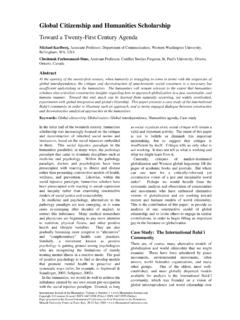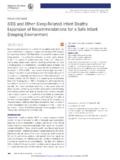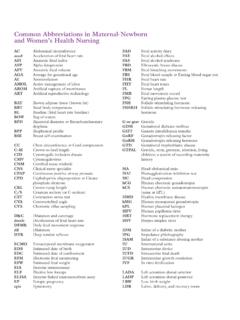Transcription of Electromyography Fundamentals
1 Electromyography FundamentalsGregory S. Rash, EdDElectromyography (EMG) is the study of muscle function through analysis of the electrical signals emanatedduring muscular contractions. Electromyography is often abused and misused by many clinicians and researchers. Manytimes even experienced electromyographers fail to provide enough information and detail on the protocols, recordingequipment and procedures used to allow other researchers to consistently replicate their studies. Hopefully, this chapter willclarify some of these problems and give the reader a basis for being able to conduct Electromyography studies as part oftheir on-going is measuring the electrical signal associated with the activation of the muscle. This may bevoluntary or involuntary muscle contraction.
2 The EMG activity of voluntary muscle contractions is related to tension. Thefunctional unit of the muscle contraction is a motor unit, which is comprised of a single alpha motor neuron and all thefibers it enervates. This muscle fiber contracts when the action potentials (impulse) of the motor nerve which supplies itreaches a depolarization threshold. The depolarization generates an electromagnetic field and the potential is measured asa voltage. The depolarization, which spreads along the membrane of the muscle, is a muscle action potential. The motorunit action potential is the spatio and temporal summation of the individual muscle action potentials for all the fibers of asingle motor unit. Therefore, the EMG signal is the algebraic summation of the motor unit action potentials within thepick-up area of the electrode being used.
3 The pick-up area of an electrode will almost always include more than one motorunit because muscle fibers of different motor units are intermingled throughout the entire muscle. Any portion of themuscle may contain fibers belonging to as many as 20-50 motor single motor unit can have 3-2,000 muscle fibers. Muscles controlling fine movements have smaller numbers ofmuscle fibers per motor units (usually less than 10 fibers per motor unit) than muscles controlling large gross movements(100-1,000 fibers per motor unit). There is a hierarchy arrangement during a muscle contraction as motor units with fewermuscle fibers are typically recruited first, followed by the motor units with larger muscle fibers. The number of motor unitsper muscle is variable throughout the the purpose of this chapter there are two main types of Electromyography : clinical (sometimes called diagnosticEMG) and kinesiological.
4 Diagnostic EMG, typically done by physiatrists and neurologists, are studies of the characteris-tics of the motor unit action potential for duration and amplitude. These are typically done to help diagnostic neuromuscu-lar pathology. They also evaluate the spontaneous discharges of relaxed muscles and are able to isolate single motor unitactivity. Kinesiological EMG is the type most found in the literature regarding movement analysis. This type of EMGstudies the relationship of muscular function to movement of the body segments and evaluates timing of muscle activitywith regard to the movements. Additionally, many studies attempt to examine the strength and force production of themuscles is a relationship of EMG to many biomechanical variables. With respect to isometric contractions, there is apositive relationship in the increase of tension within the muscle with regards to the amplitude of the EMG signal is a lag time, however, as the EMG amplitude does not directly match the build-up of isometric tension.
5 One must becareful when trying to estimate force production from the EMG signal, as there is questionable validity of the relationshipof force to amplitude when many muscles are crossing the same joint, or when muscles cross multiple joints. When lookingat muscle activity, with regards to concentric and eccentric contractions, one finds that eccentric contractions produce lessmuscle activity than concentric contraction when working against equal force. As the muscle fatigues, one sees a decreasedtension despite constant or even larger amplitude of the muscle activity. There is a loss of the high-frequency component ofthe signal as one fatigues, which can be seen by a decrease in the median frequency of the muscle signal. During move-ment, there tends to be a relationship with EMG and velocity of the movement.
6 There is an inverse relationship of strengthproduction with concentric contractions and the speed of movement, while there is a positive relationship of strengthproduction with eccentric contractions and the speed of movement. One can handle more of a load with eccentric contrac-tions at higher speed. For example: If a weight was very large and you lowered it to the ground in a fast, but controlledmanner, you handled a large weight at a high speed via eccentric contractions. You would not be able to raise the weight(concentric contraction) at the speed you were able to lower it. The forced production by the fibers are not necessarily anygreater, but you were able to handle a larger amount of weight and the EMG activity of the muscles handling that weightwould be smaller.
7 Thus, we have an inverse relationship for concentric contractions and positive relationship for eccentriccontractions with respect to speed of regards to recording the EMG signal, the amplitude of the motor unit action potential depends on manyfactors which include: diameter of the muscle fiber, distance between active muscle fiber and the detection site (adiposetissue thickness), and filtering properties of the electrodes themselves. The objective is to obtain a signal free of noise ( ,movement artifact, 60 Hz artifact, etc.). Therefore, the electrode type and amplifier characteristics play a crucial role inobtaining a noise-free kinesiological EMG there are two main types of electrodes: surface and fine wire. The surface electrodes arealso divided into two groups.
8 The first is active electrodes, which have built-in amplifiers at the electrode site to improvethe impedance (no gel is required for these and they decrease movement artifacts and increase the signal to noise ratio).The other is a passive electrode, which detect the EMG signal without a built-in amplifier, making it important to reduce allpossible skin resistance as much as possible (requires conducting gels and extensive skin preparation). With passiveelectrodes, signal to noise ratio decreases and many movement artifacts are amplified along with the actual signal onceamplification occurs. The advantages of surface electrodes are that there is minimal pain with application, they are morereproducible, they are easy to apply, and they are very good for movement applications.
9 The disadvantages of surfaceelectrodes are that they have a large pick-up area and therefore, have more potential for cross talk from adjacent , these electrodes can only be used for surface muscles. Fine wire electrodes require a needle for insertion intothe belly of the muscle. The advantages of fine wire electrodes are an increased band width, a more specific pick-up area,ability to test deep muscles, isolation of specific muscle parts of large muscles, and ability to test small muscles whichwould be impossible to detect with a surface electrode due to cross-talk. The disadvantages are that the needle insertioncauses discomfort, the uncomfortableness can increase the tightness or spasticity in the muscles, cramping sometimesoccurs, the electrodes are less repeatable as it is very difficult to place the needle/fine wires in the same area of the muscleeach time.
10 Additionally, one should stimulate the fine wires to be able to determine their location, which increased theuncomfortableness of using this type of electrode. However, for certain muscles, fine wires are the only possibility forobtaining their between the recording of surface and fine wire electrodes, in part, are related to the differences in thebandwidths. Fine wire electrodes have a higher frequency and can pick-up single motor unit activity as the fine wireelectrode band width ranges from 2-1,000 Hz, whereas surface electrode band width ranges from 10-600 Hz. Whetherusing surface or fine wire electrodes, there are some electrode configurations that can also aide in decreasing unwantednoise. A monopolar arrangement is the easiest as it is a single electrode and a ground.







